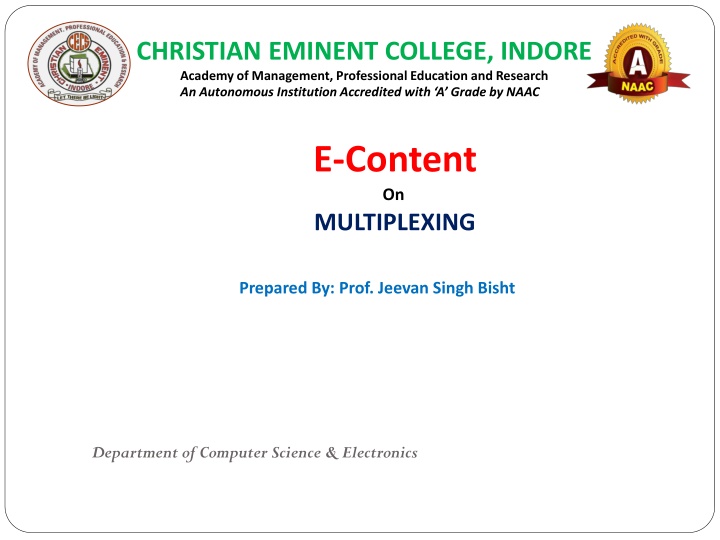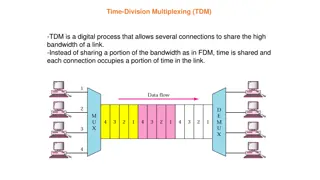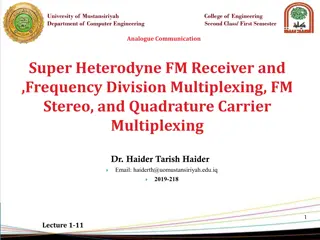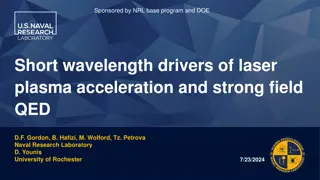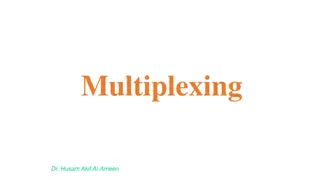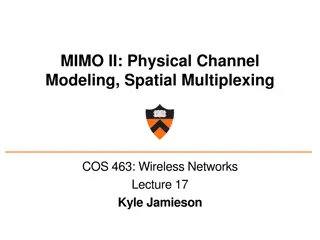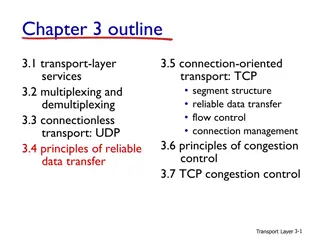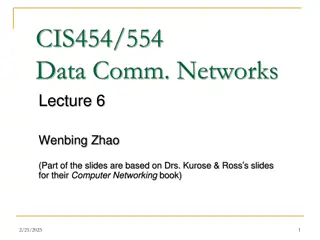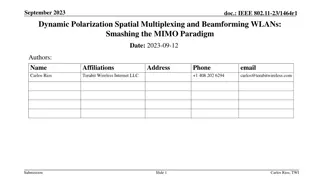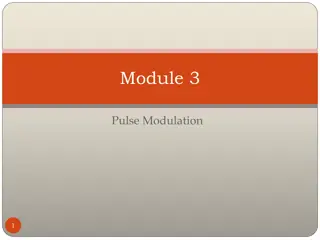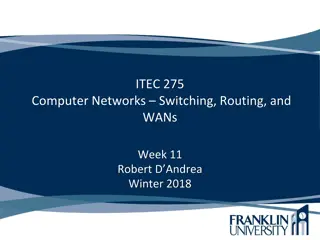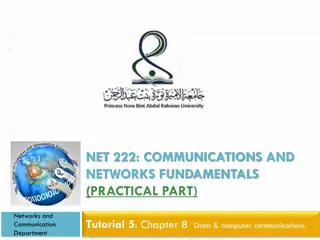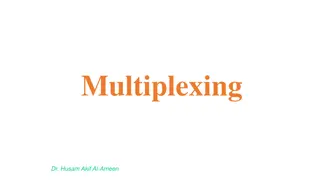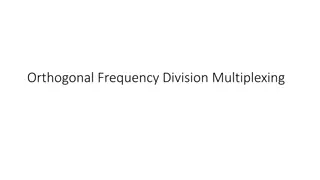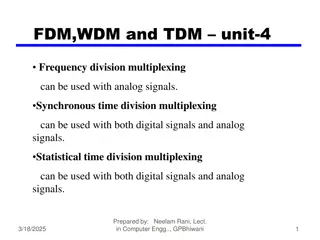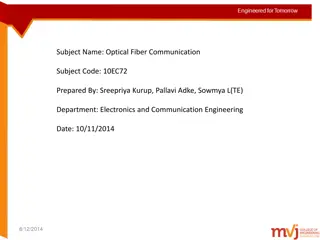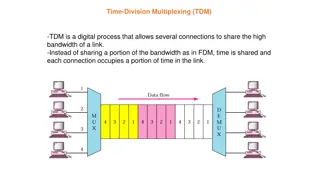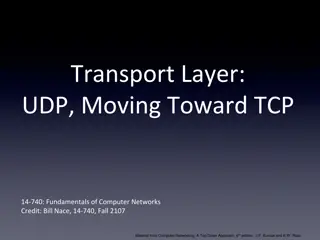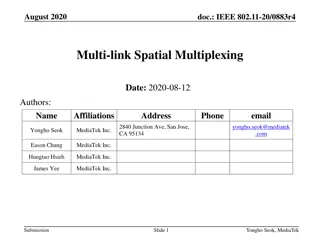Multiplexing Techniques and Applications
Multiplexing is a technique that combines multiple data streams into a single medium using devices like multiplexers and demultiplexers. Frequency Division Multiplexing (FDM) and Time Division Multiplexing (TDM) are two common types explained in detail. FDM assigns frequency ranges to different signals, reducing collisions, while TDM allocates the entire bandwidth to users for short periods. Both have various applications in telecommunications and broadcasting.
Download Presentation

Please find below an Image/Link to download the presentation.
The content on the website is provided AS IS for your information and personal use only. It may not be sold, licensed, or shared on other websites without obtaining consent from the author.If you encounter any issues during the download, it is possible that the publisher has removed the file from their server.
You are allowed to download the files provided on this website for personal or commercial use, subject to the condition that they are used lawfully. All files are the property of their respective owners.
The content on the website is provided AS IS for your information and personal use only. It may not be sold, licensed, or shared on other websites without obtaining consent from the author.
E N D
Presentation Transcript
CHRISTIAN EMINENT COLLEGE, INDORE Academy of Management, Professional Education and Research AnAutonomousInstitutionAccreditedwith A GradebyNAAC E-Content On MULTIPLEXING PreparedBy:Prof.Jeevan Singh Bisht DepartmentofComputerScience&Electronics
Multiplexing Multiplexing is a technique used to combine and send the multiple data streams over a single medium. The process of combining the data streams is known as multiplexing and hardware used for multiplexing is known as a multiplexer.
Multiplexing is achieved by using a device called Multiplexer (MUX) that combines n input lines to generate a single output line. Multiplexing follows many-to-one, i.e., n input lines and one output line. De-multiplexing is achieved by using a device called De-multiplexer (DEMUX) available at the receiving end. DEMUX separates a signal into its component signals (one input and n outputs). Therefore, we can say that de- multiplexing follows the one-to-many approach. Multiplexing is used in cases where the signals of lower bandwidth and the transmitting media are having higher bandwidth. In this case, the possibility of sending a number of signals is more. In this, the signals are combined into one and are sent over a link that has greater bandwidth of media than the communicating nodes.
Frequency Division Multiplexing A number of signals are transmitted at the same time, and each source transfers its signals in the allotted frequency range. There is a suitable frequency gap between the 2 adjacent signals to avoid over- lapping. Since the signals are transmitted in the allotted frequencies so this decreases the probability of collision. The frequency spectrum is divided into several logical channels, in which every user feels that they possess a particular bandwidth. A number of signals are sent simultaneously at the same time allocating separate frequency bands or channels to each signal. It is used in radio and TV transmission. Therefore to avoid interference channels Guard bands are used. It is an Analog technique. Frequency Division Multiplexing is a technique in which the available bandwidth of a single transmission medium is subdivided into several channels. between two successive
Application of FDM: In the first generation of mobile phones, FDM was used. The use of FDM in television broadcasting FDM is used to broadcast FM and AM radio frequencies. It uses analogue signals
Time Division Multiplexing (TDM) In TDM each user periodically gets the entire bandwidth for a small burst of time, i.e. entire channel is dedicated to one user but only for a short period of time. It is very extensively used in computer communication and telecommunication. Sharing of the channel is accomplished by dividing available transmission time on a medium among users. It exclusively uses Digital Signalling instead of dividing the cable into frequency bands. TDM splits cable usage into time slots. The data rate of transmission media exceeds the data rate of signals. Uses a frame and one slot for each slice of time and the time slots are transmitted whether the source has data or not.
It is a digital technique. In Frequency Division Multiplexing Technique, all signals operate at the same time with different frequency, but in case of Time Division Multiplexing technique, all signals operate at the same frequency with different time. In Time Division Multiplexing technique, the total time available in the channel is distributed among different users. Therefore, each user is allocated with different time interval known as a Time slot at which data is to be transmitted by the sender. A user takes control of the channel for a fixed amount of time. In Time Division Multiplexing technique, data is not transmitted simultaneously rather the data is transmitted one-by-one. In TDM, the signal is transmitted in the form of frames. Frames contain a cycle of time slots in which each frame contains one or more slots dedicated to each user. It can be used to multiplex both digital and analog signals but mainly used to multiplex digital signals.
There are two types of TDM: Synchronous TDM Asynchronous TDM Synchronous TDM A Synchronous TDM is a technique in which time slot is pre assigned to every device. In Synchronous TDM, each device is given some time slot irrespective of the fact that the device contains the data or not. If the device does not have any data, then the slot will remain empty. In Synchronous TDM, signals are sent in the form of frames. Time slots are organized in the form of frames. If a device does not have data for a particular time slot, then the empty slot will be transmitted. The most popular Synchronous TDM are T-1 multiplexing, ISDN multiplexing, and SONET multiplexing. If there are n devices, then there are n slots.
Disadvantages of Synchronous TDM: The capacity of the channel is not fully utilized as the empty slots are also transmitted which is having no data. In the above figure, the first frame is completely filled, but in the last two frames, some slots are empty. Therefore, we can say that the capacity of the channel is not utilized efficiently. The speed of the transmission medium should be greater than the total speed of the input lines. An alternative approach to the Synchronous TDM is Asynchronous Time Division Multiplexing. In the figure, the Synchronous TDM technique is implemented. Each device is allocated with some time slot. The time slots are transmitted irrespective of whether the sender has data to send or not
Asynchronous TDM An asynchronous TDM is also known as Statistical TDM. An asynchronous TDM is a technique in which time slots are not fixed as in the case of Synchronous TDM. Time slots are allocated to only those devices which have the data to send. Therefore, we can say that Asynchronous Time Division multiplexor transmits only the data from active workstations. An asynchronous TDM technique dynamically allocates the time slots to the devices. In Asynchronous TDM, total speed of the input lines can be greater than the capacity of the channel. Asynchronous Time Division multiplexor accepts the incoming data streams and creates a frame that contains only data with no empty slots. In Asynchronous TDM, each slot contains an address part that identifies the source of the data.
The difference between Asynchronous TDM and Synchronous TDM is that many slots in Synchronous TDM are unutilized, but in Asynchronous TDM, slots are fully utilized. This leads to the smaller transmission time and efficient utilization of the capacity of the channel. In Synchronous TDM, if there are n sending devices, then there are n time slots. In Asynchronous TDM, if there are n sending devices, then there are m time slots where m is less than n (m<n). The number of slots in a frame depends on the statistical analysis of the number of input lines.
Lets see that the difference between TDM and FDM: S.NO TDM FDM FDM stands for Frequency division multiplexing. 1. TDM stands for Time division multiplexing. TDM works with digital signals as well as analog signals. 2. While FDM works with only analog signals. 3. TDM has low conflict. While it has high conflict. While it s wiring or chip is complex rather than simple. 4. Wiring or chip of TDM is simple. 5. TDM is efficient. While it is inefficient. 6. In TDM, time sharing takes place. While in this, frequency sharing takes place. 7. In TDM, synchronization pulse is necessary. While in it Guard band is necessary.
Wavelength Division Multiplexing (WDM) Wavelength Division Multiplexing is same as FDM except that the optical signals are transmitted through the fibre optic cable. WDM is used on fibre optics to increase the capacity of a single fibre. It is used to utilize the high data rate capability of fibre optic cable. It is an analog multiplexing technique. Optical signals from different source are combined to form a wider band of light with the help of multiplexer. At the receiving end, de multiplexer separates the signals to transmit them to their respective destinations. Multiplexing and De multiplexing can be achieved by using a prism. Prism can perform a role of multiplexer by combining the various optical signals to form a composite signal, and the composite signal is transmitted through a fibre optical cable. Prism also performs a reverse operation, i.e., de-multiplexing the signal.
